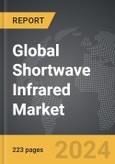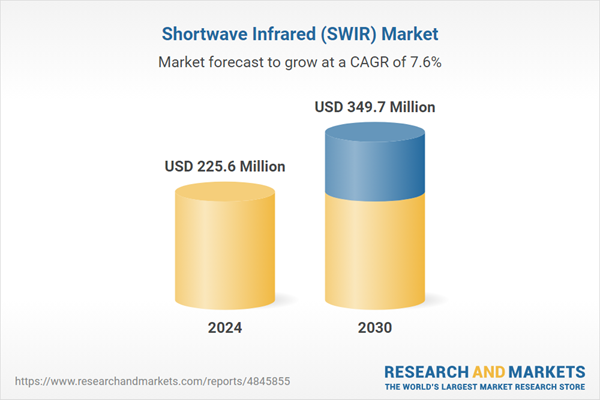The global market for Shortwave Infrared (SWIR) was valued at US$225.6 Million in 2024 and is projected to reach US$349.7 Million by 2030, growing at a CAGR of 7.6% from 2024 to 2030. This comprehensive report provides an in-depth analysis of market trends, drivers, and forecasts, helping you make informed business decisions. The report includes the most recent global tariff developments and how they impact the Shortwave Infrared (SWIR) market.
Segments: Scanning Type (Line Scan, Area Scan); Technology (Uncooled, Cooled); Vertical (Security & Surveillance, Monitoring & Inspection, Detection).
Geographic Regions/Countries: World; United States; Canada; Japan; China; Europe (France; Germany; Italy; United Kingdom; and Rest of Europe); Asia-Pacific; Rest of World.
The analysts continuously track trade developments worldwide, drawing insights from leading global economists and over 200 industry and policy institutions, including think tanks, trade organizations, and national economic advisory bodies. This intelligence is integrated into forecasting models to provide timely, data-driven analysis of emerging risks and opportunities.
Global Shortwave Infrared (SWIR) Market - Key Trends and Drivers Summarized
Why Is SWIR Imaging Gaining Prominence Across Diverse Sectors?
Shortwave Infrared (SWIR) imaging is gaining prominence across diverse sectors due to its unique ability to provide high-contrast images under low-light conditions and penetrate certain materials that visible light cannot. SWIR imaging is extensively used in defense, surveillance, industrial inspection, and scientific research for its capabilities in detecting heat signatures, identifying materials, and performing non-destructive testing. In the defense sector, SWIR cameras are crucial for night vision, target detection, and intelligence gathering, while in industrial applications, they are used for machine vision, quality control, and semiconductor inspection. The growing demand for precision, safety, and efficiency in these sectors is driving the adoption of SWIR imaging solutions.How Are Technological Advancements Driving the SWIR Market?
Technological advancements are significantly driving the SWIR market by enhancing sensor performance, reducing costs, and expanding application possibilities. Innovations in Indium Gallium Arsenide (InGaAs) sensors, which are widely used in SWIR cameras, are enabling higher sensitivity, lower noise, and wider dynamic range, improving imaging quality and expanding usability in various lighting conditions. The development of compact, lightweight, and low-power SWIR cameras is catering to the growing demand for portable and drone-mounted imaging systems. Additionally, advancements in hyperspectral imaging and integration with artificial intelligence (AI) are providing enhanced capabilities for material identification, environmental monitoring, and medical diagnostics, opening new avenues for market growth.Which Market Segments Are Leading the Adoption of SWIR Imaging?
Components of SWIR imaging systems include SWIR cameras, sensors, and lenses, with SWIR cameras being the most widely used due to their critical role in capturing high-resolution images across various wavelengths. Applications of SWIR imaging span defense, industrial inspection, agriculture, environmental monitoring, and medical diagnostics, with defense and industrial inspection leading the market due to their high demand for robust and reliable imaging solutions. End-users of SWIR imaging include defense organizations, research institutions, semiconductor manufacturers, and medical facilities, with defense organizations and semiconductor manufacturers being the primary adopters due to their need for precision imaging and material characterization. Asia-Pacific is emerging as a high-growth region driven by increasing industrialization, defense modernization, and smart city initiatives.What Are the Key Drivers of Growth in the SWIR Market?
The growth in the Shortwave Infrared (SWIR) market is driven by several factors, including the rising adoption of SWIR imaging in defense, surveillance, and security, technological advancements in InGaAs sensors and SWIR cameras, and the increasing use of SWIR in industrial inspection, machine vision, and quality control. The development of SWIR imaging solutions for medical diagnostics, non-destructive testing, and forensic applications with enhanced sensitivity, compactness, and low power consumption is driving market adoption among defense organizations, semiconductor manufacturers, and research institutions. The focus on developing SWIR solutions for precision agriculture, water resource management, and food inspection is expanding the market reach among environmental monitoring, agriculture, and food safety applications. The growing use of SWIR imaging in robotics, autonomous vehicles, and UAVs, coupled with the demand for advanced hyperspectral imaging and AI integration, is creating new opportunities for market growth. Additionally, the increasing investments in R&D for SWIR sensor miniaturization, high sensitivity, and spectral response are further supporting market expansion.Report Scope
The report analyzes the Shortwave Infrared (SWIR) market, presented in terms of units. The analysis covers the key segments and geographic regions outlined below.Segments: Scanning Type (Line Scan, Area Scan); Technology (Uncooled, Cooled); Vertical (Security & Surveillance, Monitoring & Inspection, Detection).
Geographic Regions/Countries: World; United States; Canada; Japan; China; Europe (France; Germany; Italy; United Kingdom; and Rest of Europe); Asia-Pacific; Rest of World.
Key Insights:
- Market Growth: Understand the significant growth trajectory of the Line Scan segment, which is expected to reach US$237.8 Million by 2030 with a CAGR of a 7.8%. The Area Scan segment is also set to grow at 7.0% CAGR over the analysis period.
- Regional Analysis: Gain insights into the U.S. market, valued at $62.2 Million in 2024, and China, forecasted to grow at an impressive 7.0% CAGR to reach $54.0 Million by 2030. Discover growth trends in other key regions, including Japan, Canada, Germany, and the Asia-Pacific.
Why You Should Buy This Report:
- Detailed Market Analysis: Access a thorough analysis of the Global Shortwave Infrared (SWIR) Market, covering all major geographic regions and market segments.
- Competitive Insights: Get an overview of the competitive landscape, including the market presence of major players across different geographies.
- Future Trends and Drivers: Understand the key trends and drivers shaping the future of the Global Shortwave Infrared (SWIR) Market.
- Actionable Insights: Benefit from actionable insights that can help you identify new revenue opportunities and make strategic business decisions.
Key Questions Answered:
- How is the Global Shortwave Infrared (SWIR) Market expected to evolve by 2030?
- What are the main drivers and restraints affecting the market?
- Which market segments will grow the most over the forecast period?
- How will market shares for different regions and segments change by 2030?
- Who are the leading players in the market, and what are their prospects?
Report Features:
- Comprehensive Market Data: Independent analysis of annual sales and market forecasts in US$ Million from 2024 to 2030.
- In-Depth Regional Analysis: Detailed insights into key markets, including the U.S., China, Japan, Canada, Europe, Asia-Pacific, Latin America, Middle East, and Africa.
- Company Profiles: Coverage of players such as Allied Vision Technologies GmbH, Biospace LAB, Episensors, Inc., Hamamatsu Photonics KK, IRCameras LLC and more.
- Complimentary Updates: Receive free report updates for one year to keep you informed of the latest market developments.
Some of the 46 companies featured in this Shortwave Infrared (SWIR) market report include:
- Allied Vision Technologies GmbH
- Biospace LAB
- Episensors, Inc.
- Hamamatsu Photonics KK
- IRCameras LLC
- Korea Photonics Technology Institute
- New Imaging Technologies (NIT)
- Omek Optics Ltd.
- PhosphorTech Corporation
- Photon Etc Inc.
Tariff Impact Analysis: Key Insights for 2025
Global tariff negotiations across 180+ countries are reshaping supply chains, costs, and competitiveness. This report reflects the latest developments as of April 2025 and incorporates forward-looking insights into the market outlook.The analysts continuously track trade developments worldwide, drawing insights from leading global economists and over 200 industry and policy institutions, including think tanks, trade organizations, and national economic advisory bodies. This intelligence is integrated into forecasting models to provide timely, data-driven analysis of emerging risks and opportunities.
What’s Included in This Edition:
- Tariff-adjusted market forecasts by region and segment
- Analysis of cost and supply chain implications by sourcing and trade exposure
- Strategic insights into geographic shifts
Buyers receive a free July 2025 update with:
- Finalized tariff impacts and new trade agreement effects
- Updated projections reflecting global sourcing and cost shifts
- Expanded country-specific coverage across the industry
Table of Contents
I. METHODOLOGYII. EXECUTIVE SUMMARY2. FOCUS ON SELECT PLAYERSIII. MARKET ANALYSISREST OF WORLDIV. COMPETITION
1. MARKET OVERVIEW
3. MARKET TRENDS & DRIVERS
4. GLOBAL MARKET PERSPECTIVE
UNITED STATES
CANADA
JAPAN
CHINA
EUROPE
FRANCE
GERMANY
ITALY
UNITED KINGDOM
REST OF EUROPE
ASIA-PACIFIC
Companies Mentioned (Partial List)
A selection of companies mentioned in this report includes, but is not limited to:
- Allied Vision Technologies GmbH
- Biospace LAB
- Episensors, Inc.
- Hamamatsu Photonics KK
- IRCameras LLC
- Korea Photonics Technology Institute
- New Imaging Technologies (NIT)
- Omek Optics Ltd.
- PhosphorTech Corporation
- Photon Etc Inc.
Table Information
| Report Attribute | Details |
|---|---|
| No. of Pages | 223 |
| Published | April 2025 |
| Forecast Period | 2024 - 2030 |
| Estimated Market Value ( USD | $ 225.6 Million |
| Forecasted Market Value ( USD | $ 349.7 Million |
| Compound Annual Growth Rate | 7.6% |
| Regions Covered | Global |









